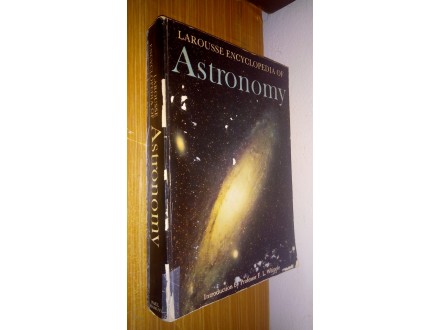Larousse/ Enciklopedija Astronomije/ Engleski
| Cena: |
| Želi ovaj predmet: | 10 |
| Stanje: | Polovan sa vidljivim znacima korišćenja |
| Garancija: | Ne |
| Isporuka: | Post Express |
| Plaćanje: | Tekući račun (pre slanja) Pouzećem |
| Grad: |
Beograd-Ralja, Beograd-Sopot |
ISBN: Ostalo
Oblast: Astronomija
Godina izdanja: ccc
Jezik: Engleski
Autor: Strani
Larousse Encyclopedia of Astronomy
Lucien Rudaux & G. de Vaucouliers
Veliki format
Engleski jezik
Ilustrovana
1966god
506 strana
Mek povez
A profusely illustrated treatise dealing with the background, methodology, and concept of astronomy. Includes 19 chapters in four parts; (1) The splendour of the heavens, (2) The empire of the sun, (3) The realm of the stars, and (4) Astronomical instruments and techniques.
Korice iskrzane i rikna lepljena, unutrašnjost očuvana
The Larousse Encyclopedia of Astronomy first came off the printing press back in 1959, in a unique collaboration between the French professional astronomer, Gérard Henri de Vaucouleurs (1918–1995) and his compatriot, the distinguished amateur astronomer and artist, Lucien Rudaux(1874-1947). It was a match made in heaven, for this superb fusion of art and science enjoyed a number of reprintings, first in 1962 and finally in 1966. The edition I discuss here was published in 1966, which included an introduction written by the distinguished American astronomer, Fred L. Whipple(1906-2004) of comet fame.
the work is divided into 4 sections or ‘books,’ which include;
Book I: The Splendour of the Heavens
Book II: The Empire of the Sun
Book III: The Realm of the Stars
Book IV: Astronomical Instruments and Techniques
Book I: The Splendour of the Heavens
Book I, which has two chapters, deals with the elements of physical astronomy and is wonderfully illustrated throughout. It provides the reader with a basic, albeit solid grounding in how the sky works. This is classical knowledge, as true today as the day it was penned.
Book II Empire of the Sun
Many classic stories are recounted in the text, including the once seriously considered planet Vulcan, thought to orbit the Sun closer in than Mercury. There is even a diagram showing the hypothetical orbit as envisioned by the great French astronomer, Urbain Le Verrier(1811-1877).
We are prone to forget that the Earth is a planet in its own right but the Larousse Encyclopedia we get an exquisite overview of the many and various meteorological phenomena that make our world so spectacular.
Moving on to our nearest neighbour in space, the Larousse excels with some fine, high- resolution images of the lunar regolith. What may surprise a few readers is that some very detailed lunar images were made using the 100-inch Hooker reflector atop Mount Wilson. This giant eye on the sky is far more famous for the seminal contributions it made to cosmology, especially Edwin Hubble’s discovery that the Universe is expanding.
Chronicling also features a detailed chapter on the Great Meudon Refractor, located just outside Paris, which once represented the brain and glory of late 19th and early 20th century French astronomical science. The reader of Larousse will be in for quite a treat in the chapter covering the planets, as many of the exquisite drawings came directly from the French tradition. As well as drawings made by Rudaux, who was inspired by the eccentric French astronomer, Camille Flammarion(1842-1925) there are also exquisite renderings from de Vaucouleurs, who made use of a fine 8 inch classical refractor based at Houga Observatory(founded in 1933 by the amateur astronomer and electrical engineer, Julien Peridier), France, during the late 1930s and early 1940s. Many other planetary sketches were made by distinguished French observers such as Bernard Lyot, H. Camichel and M. Gentili, making use of a superb 15 inch refractor at the Pic du Midi Observatory in the French Pyrenees.This Observatory, which is still alive and well, attracts some of the finest planetary imagers in the world (including the UK’s Damien Peach) who have produced some of the best CCD images of the major planets yet taken from the Earth, owing to the superb astronomical seeing manifested at this high-altitude site.
The section on the planet Mars is partcularly interesting. As the drawings made in 1941 reveal below, even professsional astronomers like de Vaucouleurs were still actively engaged in visual observations;
https://www.kupindo.com/Drama/80654241_Kapi-kise-u-solji-caja-Roman-Iv-Nikols
Pogledajte naše MAGNETNI BUKMARKERI :
https://www.kupindo.com/Ostalo/78848793_Magnetni-Bookmarkeri-Bukmarkeri-Obelezivaci-strana
POPUST!!!
Potrebno je da ispunjavate sva 3 uslova popusta:
1. Popust NE VAZI za knjige čija je pojedinačna cena preko 490 dinara i ne važi za komplete knjiga
2. Ako odlučite da kupite knjige (koje nisu skuplje od 490 din i nisu kompleti) u vrednosti od minimum 2000 dinara , PRVO me kontaktirajte preko KUPINDO poruka (da bih korigovala cene) i DOBICETE POPUST OD 10%
U poruci napišite: Svrha poruke - Popust
Obavezan spisak knjiga sa cenama pre kupovine
3. Popust NE važi NAKON sto obavite kupovinu vec isključivo PRE nego sto počnete da kupujete
*****************************************************************
Pakovanje naplaćujemo 10 dinara po pošiljci
*********************************************************************
Knjige saljemo:
- kao preporucene tiskovine NE ŠALJEMO KNJIGE KAO OBIČNU TISKOVINU
- kao paket - plaćate knjige i poštarinu UNAPRED, NEMA OPCIJE da poštarinu za paket platite prilikom preuzimanja
- post expresom Plaćanje POUZEĆEM znači da šaljemo POST EXPRESOM (NE ŠALJEMO CC paket pouzećem)
- Ako šaljemo pošiljku na adresu firme post expres insistira na nazivu firme koji se piše u napomeni
Postoji mogućnost da nema opcije post expresa:
- ako kupac ima negativne ocene
- u specifičnim slučajevima ako zaključimo da kupac nije pouzdan - nepostojeći broj telefona, knjiga mora stići u određenom roku zbog putovanja i sl.
****************************************************
Ne šaljemo knjige u inostranstvo tj izvan Srbije
Naše knjige pogledajte: http://www.kupindo.com/Clan/IvanaIg/SpisakPredmeta
Pogledajte našu ponudu Magnetni Bookmarkeri
https://www.kupindo.com/Ostalo/78848793_Magnetni-Bookmarkeri-Bukmarkeri-Obelezivaci-strana
i
https://www.kupindo.com/Ostalo/78848877_Magnetni-Bookmarkeri-Bukmarkeri-Obelezivaci-strana
Predmet: 63225533











